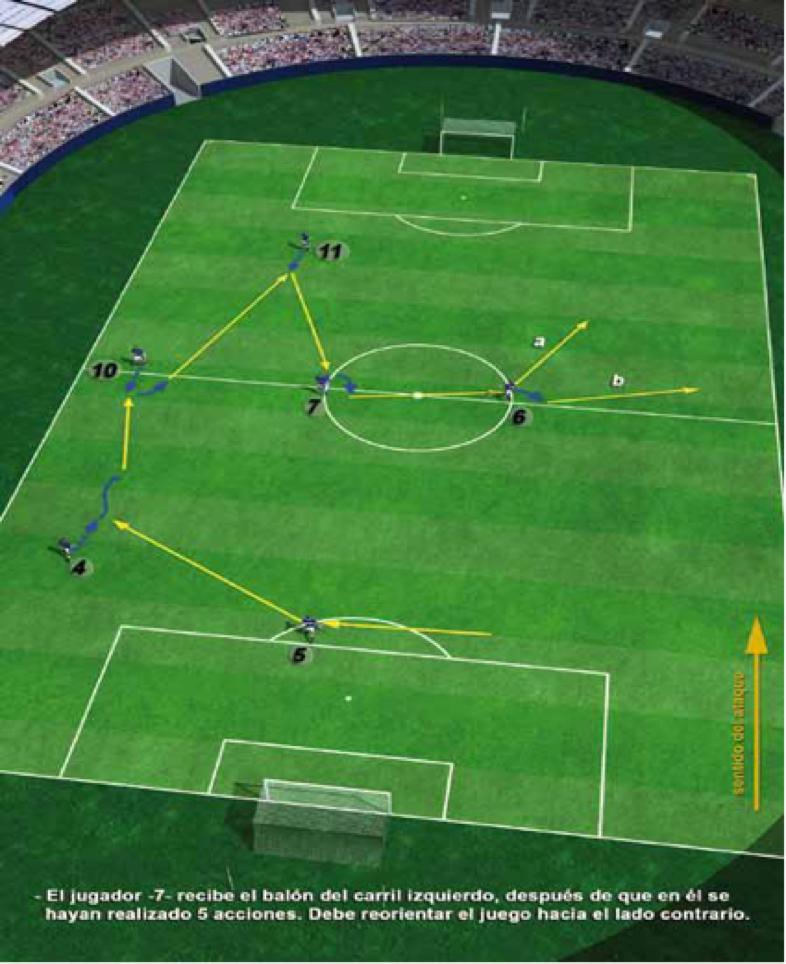| If the ball is handled in the start/progression zone in the same zone/rail with more than 4-5 touches, without reaching the end zone, a direct or indirect orientation change towards the free zone/rail should be made. If the lane in which progress is progressed is the centrallane, the reorientation of the game will be made towards the opposite lane from which the ball came. The 4/5 touches correspond to a certain time. This time could be longer or shorter relative to the quality of the holder to keep it at no risk of loss.
|
Graphic

Considerations
When:
- In the progression zone, four or more touches have been made in the same lane (right, central or left) without reaching the end zone with the possibility of completion, implies a time that is taken advantage of by the opposing team to swing towards that area, thus eliminating the spaces necessary to maintain possession of the ball.
- In both cases you have to take the ball out of this area to avoid its loss.
If the ball is maintained, or returns to this demarcation, there will be a very high chance that possession will be lost.
- The orientation changes will not only prevent the loss of the ball in the demarcation in which the 4/5 touches have previously been made (or in which it has been recovered), but will allow in the opposite demarcation (where there are free spaces) to reach the end zone with a manifest advantage.
- If the opposite does not swing defensively by strictly marking the man (atypical situation in current football), it is obvious that through the previous touches we will have overcome the opponents by an action of 1:1 (haggling with long exit) / wall, with a collective action of 2:1 with the incorporation of a free player of the LD, with or without ball (since there is in this line a clear numerical superiority in relation to the tips), or with the incorporation in the area of the holder of a tip or a player of the same LM.
- The change of orientation must be done with power and precision (directly or indirectly – triangulating with a partner of another line-), while receptions must be made by orienting the ball and playing it at two touches (reception-pass), so that the opposite cannot rectify its position towards the free spaces before the arrival of the ball.
- For this action to be effective, balance must be constantly manifested in and between lines (amplitude and depth), with players on the line being maintained equidistant from each other.
- If the opposite plays with a forward defensive line and completely closes the spaces (preventing even the direct orientation changes to the other lane) we will look for a "long" orientation change with high balls, directed towards the corner area on the opposite side where the ball is located to take advantage of the large spaces existing behind the opposite LD (short-to-long play style).
- The orientation changes may be:
- Direct (Towards a player of the same line).
- Indirect (triangulating with a partner from another line). More effective in causing the "fixation" and attention of the opposing defender towards this area in this first pass and the reception of the partner in second play (time/space).
- Long (change of orientation high in depth when there are no spaces to handle the ball in short and / or large spaces have been created in the opposite area of the holder).
- When one of the players in center lane receives the ball from a teammateon another line, and plays it at the first touch in depth, he will do so by orienting the ball to the opposite side of the one that came from.
- We will consider a valid exception to this rule if a wall is made to the side where the ball comes from only when behind the players participating in the wall (the player in the center lane and the side rail) there is no opposite (or that due to the distance at which it is unable to access the ball).
Aimed at
The player who receives and plays the ball in the Home and Progression sub-phases
Training Goals
Do not lose possession of the ball in the realization of the associative/positional style of play
Video
VIDEO (FUP3i): Remove the ball from the zone/rail after 4-5 taps INCORRECT MANIFESTATION
VIDEO (FUP3c): Remove the ball from the area/rail after 4-5 taps CORRECT MANIFESTATION
